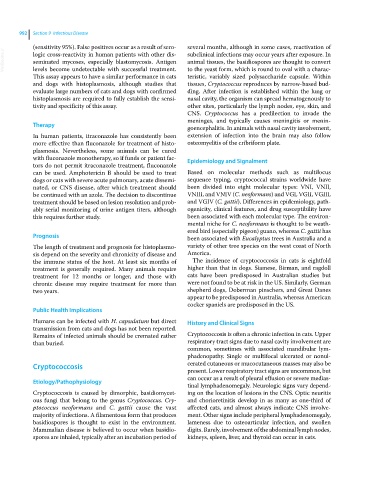Page 1054 - Clinical Small Animal Internal Medicine
P. 1054
992 Section 9 Infectious Disease
(sensitivity 95%). False positives occur as a result of sero several months, although in some cases, reactivation of
VetBooks.ir logic cross‐reactivity in human patients with other dis subclinical infections may occur years after exposure. In
animal tissues, the basidiospores are thought to convert
seminated mycoses, especially blastomycosis. Antigen
levels become undetectable with successful treatment.
teristic, variably sized polysaccharide capsule. Within
This assay appears to have a similar performance in cats to the yeast form, which is round to oval with a charac
and dogs with histoplasmosis, although studies that tissues, Cryptococcus reproduces by narrow‐based bud
evaluate large numbers of cats and dogs with confirmed ding. After infection is established within the lung or
histoplasmosis are required to fully establish the sensi nasal cavity, the organism can spread hematogenously to
tivity and specificity of this assay. other sites, particularly the lymph nodes, eye, skin, and
CNS. Cryptococcus has a predilection to invade the
meninges, and typically causes meningitis or menin
Therapy goencephalitis. In animals with nasal cavity involvement,
In human patients, itraconazole has consistently been extension of infection into the brain may also follow
more effective than fluconazole for treatment of histo osteomyelitis of the cribriform plate.
plasmosis. Nevertheless, some animals can be cured
with fluconazole monotherapy, so if funds or patient fac Epidemiology and Signalment
tors do not permit itraconazole treatment, fluconazole
can be used. Amphotericin B should be used to treat Based on molecular methods such as multilocus
dogs or cats with severe acute pulmonary, acute dissemi sequence typing, cryptococcal strains worldwide have
nated, or CNS disease, after which treatment should been divided into eight molecular types: VNI, VNII,
be continued with an azole. The decision to discontinue VNIII, and VNIV (C. neoformans) and VGI, VGII, VGIII,
treatment should be based on lesion resolution and prob and VGIV (C. gattii). Differences in epidemiology, path
ably serial monitoring of urine antigen titers, although ogenicity, clinical features, and drug susceptibility have
this requires further study. been associated with each molecular type. The environ
mental niche for C. neoformans is thought to be weath
ered bird (especially pigeon) guano, whereas C. gattii has
Prognosis been associated with Eucalyptus trees in Australia and a
The length of treatment and prognosis for histoplasmo variety of other tree species on the west coast of North
sis depend on the severity and chronicity of disease and America.
the immune status of the host. At least six months of The incidence of cryptococcosis in cats is eightfold
treatment is generally required. Many animals require higher than that in dogs. Siamese, Birman, and ragdoll
treatment for 12 months or longer, and those with cats have been predisposed in Australian studies but
chronic disease may require treatment for more than were not found to be at risk in the US. Similarly, German
two years. shepherd dogs, Doberman pinschers, and Great Danes
appear to be predisposed in Australia, whereas American
cocker spaniels are predisposed in the US.
Public Health Implications
Humans can be infected with H. capsulatum but direct History and Clinical Signs
transmission from cats and dogs has not been reported.
Remains of infected animals should be cremated rather Cryptococcosis is often a chronic infection in cats. Upper
than buried. respiratory tract signs due to nasal cavity involvement are
common, sometimes with associated mandibular lym
phadenopathy. Single or multifocal ulcerated or nonul
Cryptococcosis cerated cutaneous or mucocutaneous masses may also be
present. Lower respiratory tract signs are uncommon, but
can occur as a result of pleural effusion or severe medias
Etiology/Pathophysiology
tinal lymphadenomegaly. Neurologic signs vary depend
Cryptococcosis is caused by dimorphic, basidiomycet ing on the location of lesions in the CNS. Optic neuritis
ous fungi that belong to the genus Cryptococcus. Cry and chorioretinitis develop in as many as one‐third of
ptococcus neoformans and C. gattii cause the vast affected cats, and almost always indicate CNS involve
majority of infections. A filamentous form that produces ment. Other signs include peripheral lymphadenomegaly,
basidiospores is thought to exist in the environment. lameness due to osteoarticular infection, and swollen
Mammalian disease is believed to occur when basidio digits. Rarely, involvement of the abdominal lymph nodes,
spores are inhaled, typically after an incubation period of kidneys, spleen, liver, and thyroid can occur in cats.

